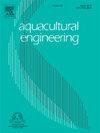Optimization of aerobic digestion conditions of solid waste from recirculating aquaculture systems for liquid fertilizer production
IF 4.3
2区 农林科学
Q2 AGRICULTURAL ENGINEERING
引用次数: 0
Abstract
Recycling nutrients from aquaculture sludge can contribute to more sustainable production systems and support circular economy approaches. This study evaluated aerobic digestion as a treatment strategy for solid organic waste generated in recirculating aquaculture systems (RAS) for African catfish (Clarias gariepinus), with the aim of optimizing operational conditions for maximum nutrient mineralization and recovery. A multifactorial experiment was conducted using four treatments (control, pH 6, pH 7, bacterial inoculation), each tested at three temperatures (20, 25, 30 °C) in triplicate (36 reactors in total). Each reactor was loaded with 10 g of freeze-dried sludge and 1 L of water or phosphate buffer. Digestion proceeded for 21 days. The most effective condition was the control treatment at 30 °C without pH adjustment or bacterial inoculation. Under this setting, the final nitrate concentration reached 81.4 mg/L. Phosphorus recovery efficiency (NRE) was 61.1 %, and potassium recovery reached 76.8 %. The final nutrient solution had a favorable NO₃⁻:NH₄⁺ ratio of 75:25. Higher temperature promoted nitrification and overall mineralization. Acidified conditions (pH 6) enhanced ammonium and phosphorus solubilization but slowed nitrate formation. The addition of external bacteria did not improve mineralization efficiency, likely due to microbial competition or limited inoculum performance. Heavy metals were below detection limits. However, persistent nitrite concentrations (∼4–5 mg/L) and poor solubilization of micronutrients, especially Fe and Zn, remain limitations. Laboratory-scale pretreatment (freeze-drying and milling) may have improved solubility compared to raw sludge and should be considered when interpreting results. The results suggest that optimized aerobic digestion of RAS sludge can support efficient nutrient recovery and may serve as a practical approach for producing liquid fertilizer applicable in hydroponics.
水肥生产循环水养殖系统固体废物好氧消化条件的优化
从水产养殖污泥中回收养分可以促进更可持续的生产系统,并支持循环经济方法。本研究评估了好氧消化作为循环养殖系统(RAS)中非洲鲶鱼(Clarias gariepinus)产生的固体有机废物的处理策略,旨在优化操作条件,以最大限度地实现养分矿化和回收。采用4个处理(对照、pH 6、pH 7、细菌接种)进行多因素试验,每个处理在3个温度(20、25、30℃)下进行试验,共36个反应器。每个反应器装载10 g冻干污泥和1 L水或磷酸盐缓冲液。消化21 d。最有效的条件是30℃对照处理,不调整pH值,不接种细菌。在此设置下,最终硝酸盐浓度达到81.4 mg/L。磷回收率(NRE)为61.1 %,钾回收率为76.8% %。最终营养液的NO₃⁻:NH₄⁺的比例为75:25。高温促进硝化作用和整体矿化。酸化条件(pH 6)增强了铵和磷的增溶作用,但减缓了硝酸盐的形成。外部细菌的添加并没有提高矿化效率,可能是由于微生物竞争或有限的接种性能。重金属含量低于检测限值。然而,持续的亚硝酸盐浓度(~ 4-5 mg/L)和微量营养素(特别是铁和锌)的溶解性差仍然是限制因素。与原始污泥相比,实验室规模的预处理(冷冻干燥和碾磨)可能具有更好的溶解度,在解释结果时应考虑到这一点。结果表明,优化RAS污泥的好氧消化可以支持有效的养分回收,并可作为生产适用于水培的液肥的实用方法。
本文章由计算机程序翻译,如有差异,请以英文原文为准。
求助全文
约1分钟内获得全文
求助全文
来源期刊

Aquacultural Engineering
农林科学-农业工程
CiteScore
8.60
自引率
10.00%
发文量
63
审稿时长
>24 weeks
期刊介绍:
Aquacultural Engineering is concerned with the design and development of effective aquacultural systems for marine and freshwater facilities. The journal aims to apply the knowledge gained from basic research which potentially can be translated into commercial operations.
Problems of scale-up and application of research data involve many parameters, both physical and biological, making it difficult to anticipate the interaction between the unit processes and the cultured animals. Aquacultural Engineering aims to develop this bioengineering interface for aquaculture and welcomes contributions in the following areas:
– Engineering and design of aquaculture facilities
– Engineering-based research studies
– Construction experience and techniques
– In-service experience, commissioning, operation
– Materials selection and their uses
– Quantification of biological data and constraints
 求助内容:
求助内容: 应助结果提醒方式:
应助结果提醒方式:


